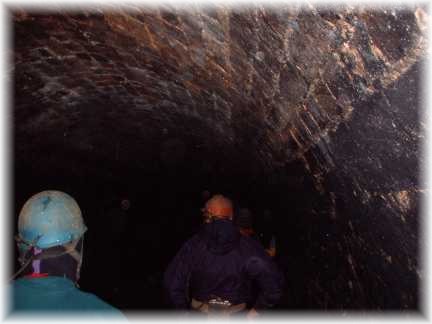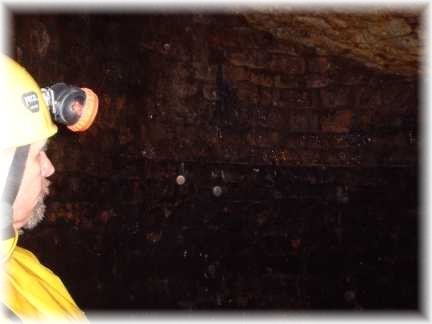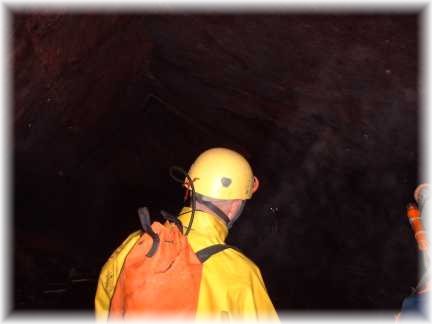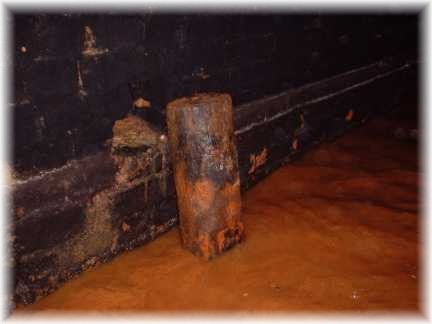
- Coal
- Mow Cop Colliery
- Engineers Plans
- The Tunnel
- Falls Colliery
- Williamsons
- Rail Track
- Map 1890
- Map ofTramway
- Harriseahead Coal
- Astbury Lime Works
The Tunnel
Thursday 15th January 7:00pm we all met on the car park at Woodcocks Well School car park, I soon began to feel under-dressed as the other 10 people donned complete all in one skin tight water proofs, and there was I jacket jeans and waders. I was reliably informed though that waders should be enough.
Off we set under cover of darkness, we didn't wish to alarm the residents, and more importantly we didn't want any minors seeing what we up to. Children have a peculiar habit of disappearing down holes given half the chance.
The tunnel had been opened up only a few weeks prior as Len Kirkham and Ralph had been asked to make a video, Len however had done a survey on the tunnel some 10 years previous.
We removed the stones that covered the tunnel entrance, or exit as the case would have been and climbed down into the darkness. I carried what was a pretty impressive spotlight/torch borrowed from my brother; the rest had miners helmets that lit the place up very well indeed.
The orange silt filled water only came up to my knees, which was quite a relief. We took a few photos and then started the steady trek through the tunnel, there were plenty of rocks under foot and the tunnel floor was very uneven so care was needed. I was surprised at the height of the tunnel it was at least 7ft high, it certainly didnít look that high on the old photograph I have.
- Limeworks Video
- Tunnel
Video
The Tunnel is now sealed and is on private property. there is no public access. - In Depth Study by Len Kirkham
The tunnel itself is as straight as a
dye and has 2 very slight inclines leading to the centre from both ends. What
surprised me more was that 1/3 of the way in the tunnel we came across a circular
extension. At first you could be forgiven for thinking that they had started
to build an airshaft leading up, but this was very unlikely. This round part
in the tunnel doubled the width of the tunnel, and was a perfect circle. The
most likely explanation was that the horses were turned round at this point
as the rest of the journey would have been down bank; and a man could have
pushed the coal filled carts down to the break winding drum easily thus freeing
the horses to go and fetch the next load. Len also informed me that the local
coal miners at the time bred their own horses, Clydesdales being ideal for
the job. They were stabled at Towerhill part way along the track in what was
believed to be the engine house.
We continued to the end of the tunnel, this time going on the downwards slope
to sealed end, just up from the Ash Inn; to my obvious disappointment the
water started to get deeper. In fact I remarked on it's temperature at it
seeped over the top of the waders. I was glad to turn round and start walking
back.
The roof is a little unstable in a few places, probably where the roads pass
over the top, the wall are covered in coal dust and hanging from the ceilings
are straw stalactites that have been made up from years of dripping water.
The tunnel has been nearly full to the top with water as you can see a very
clear water line mark. There are the odd wooden sleepers that have been left
scattered, apparently they were placed at an angle to each other to help keep
them stable and the tracks parallel with the heavy trucks pushing down. As
well as the usual brickwork, there are are a few places where the gritsone
has been left, these makes small cavern like structures, 10ft high in places.
THE TUNNEL HAS KNOW BEEN RE-SEALED.


Part way through there was a turning point
 Some
parts were not bricked at all
Some
parts were not bricked at all
Chisel found in the Tunnel

Brackish Water, Coal Dust lines walls and a sleeper by a water drain